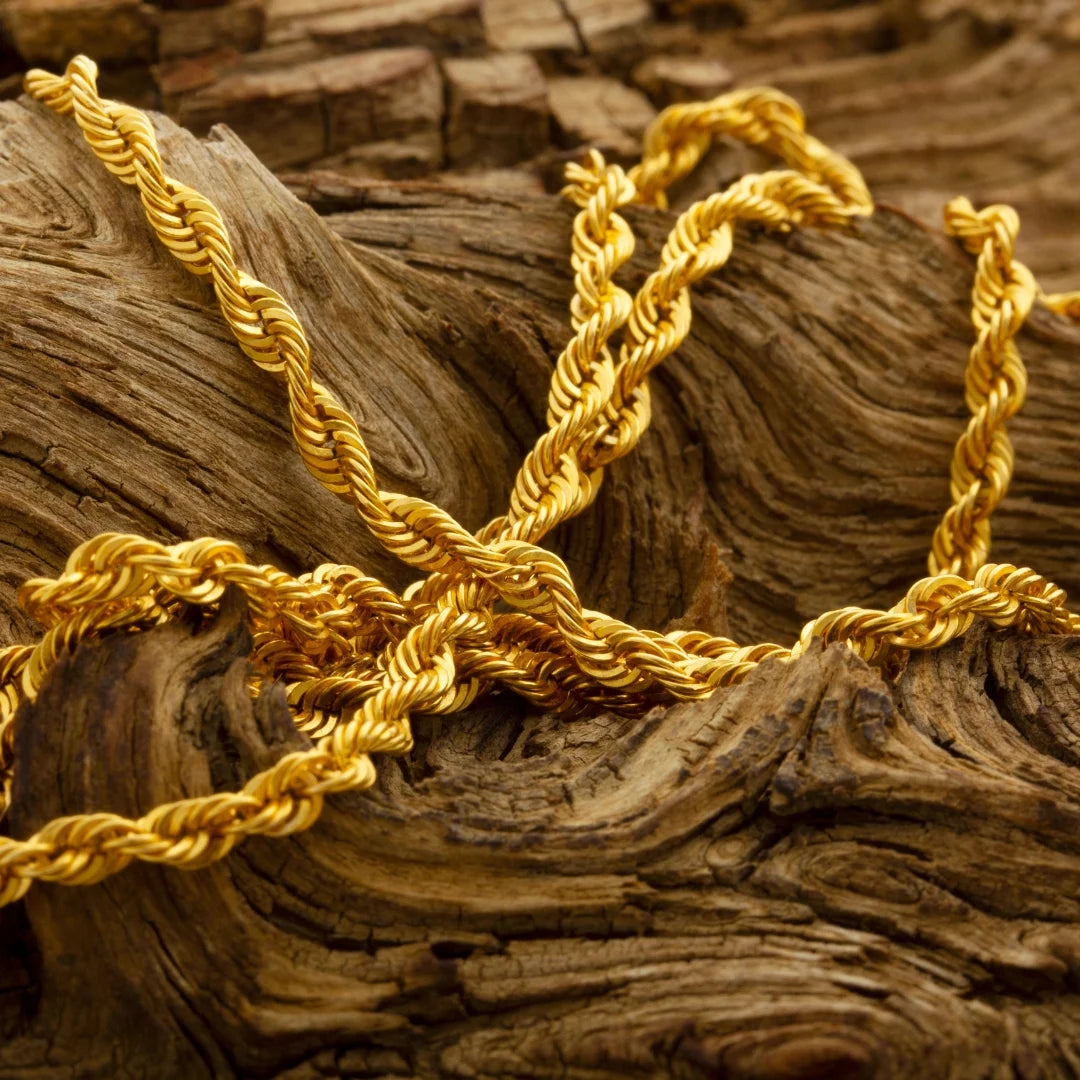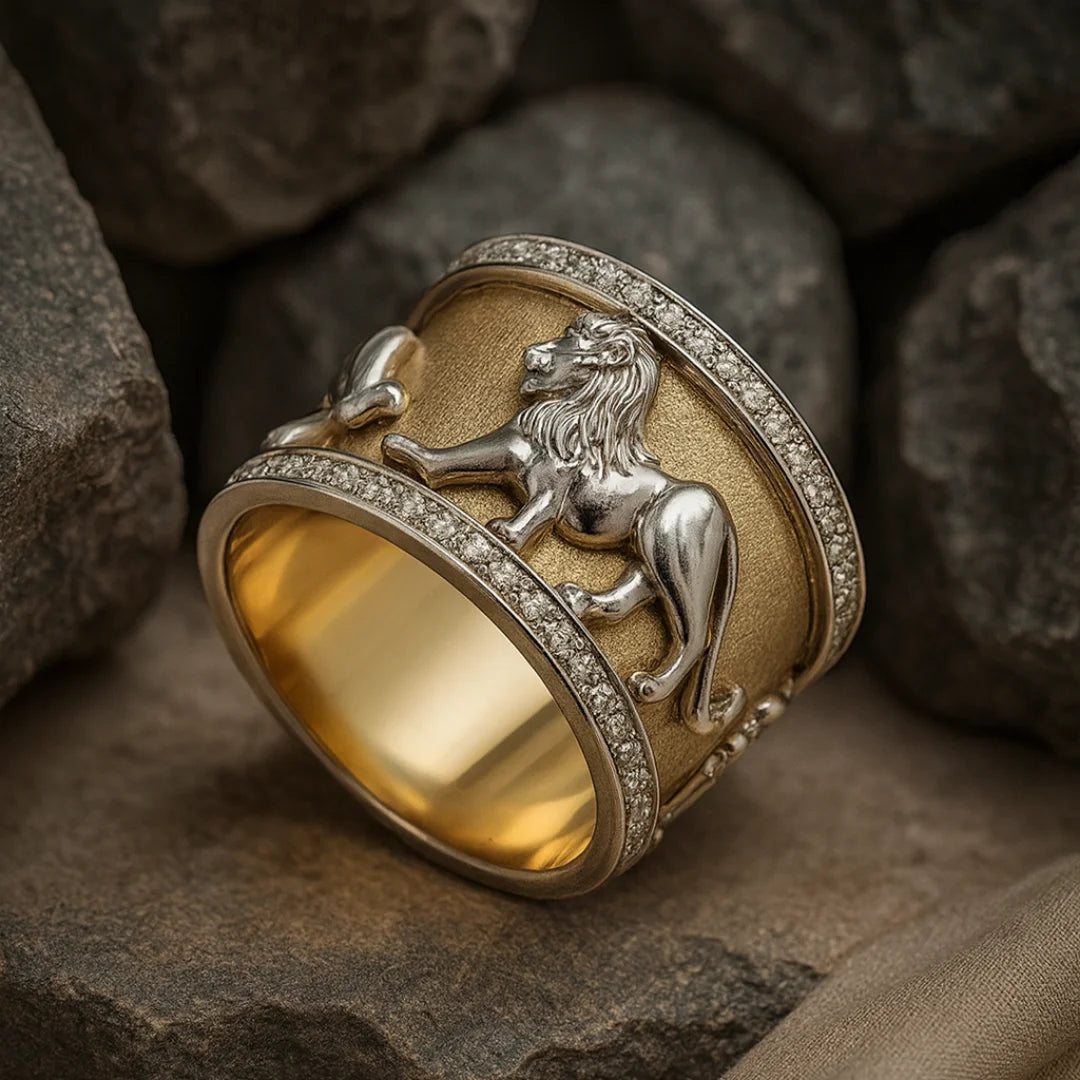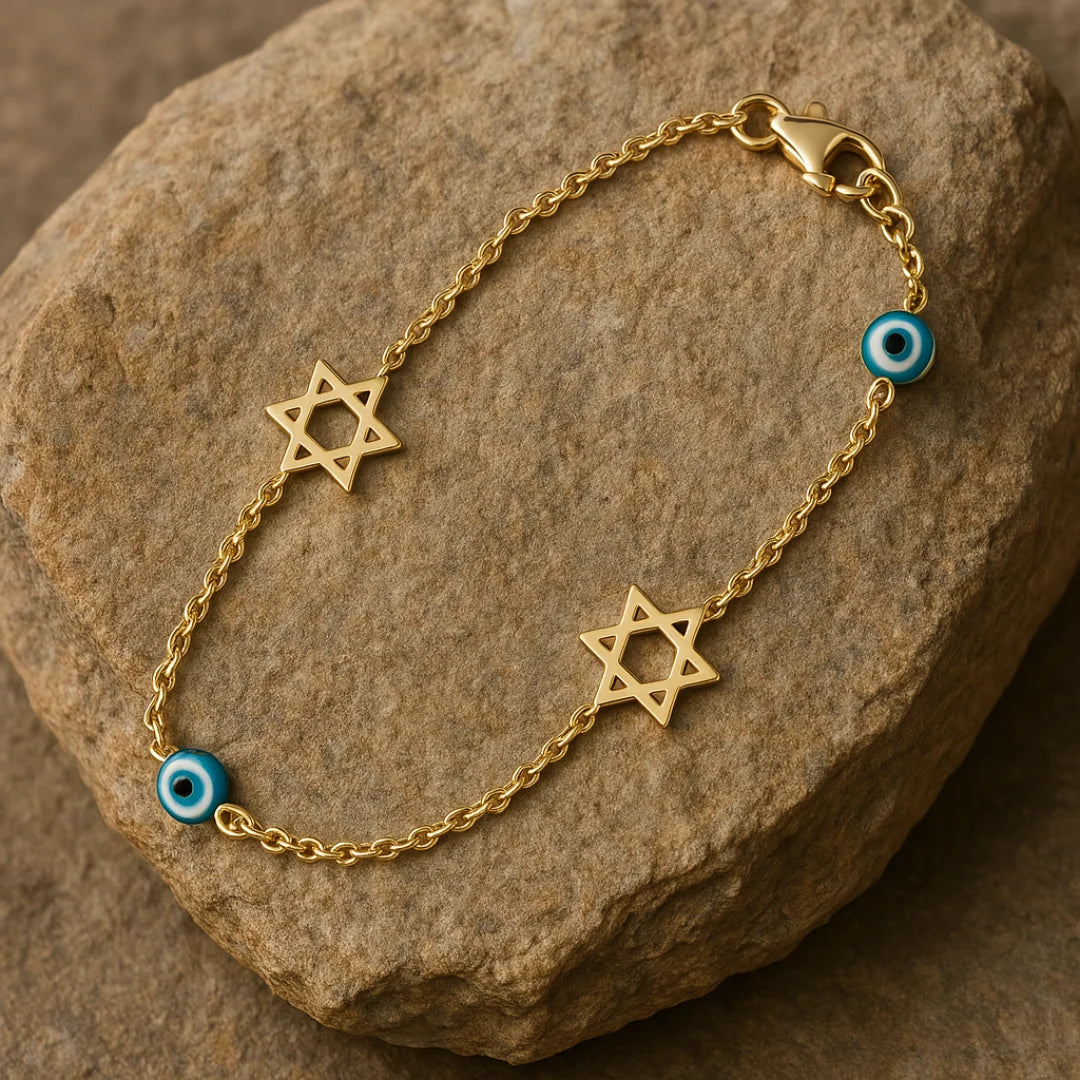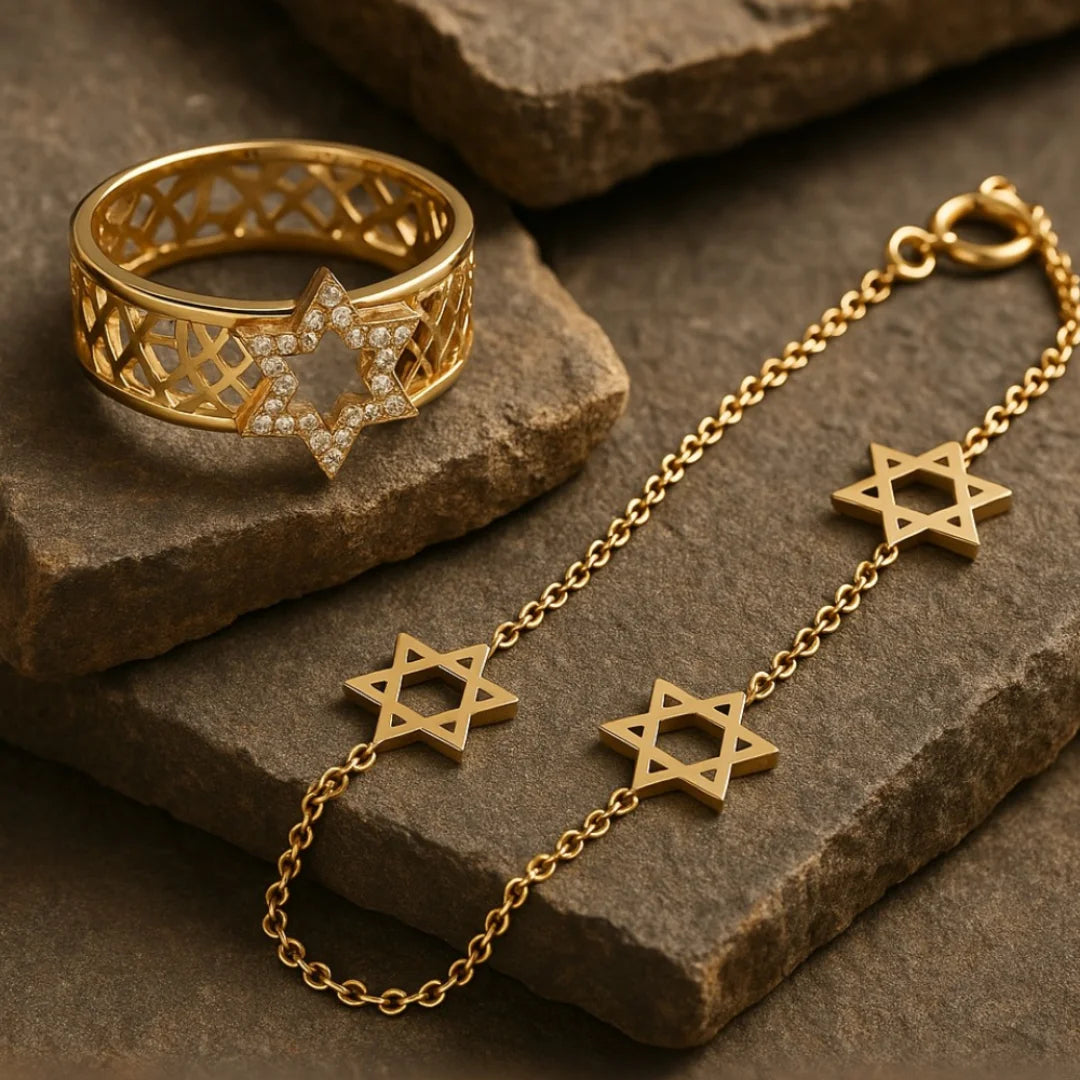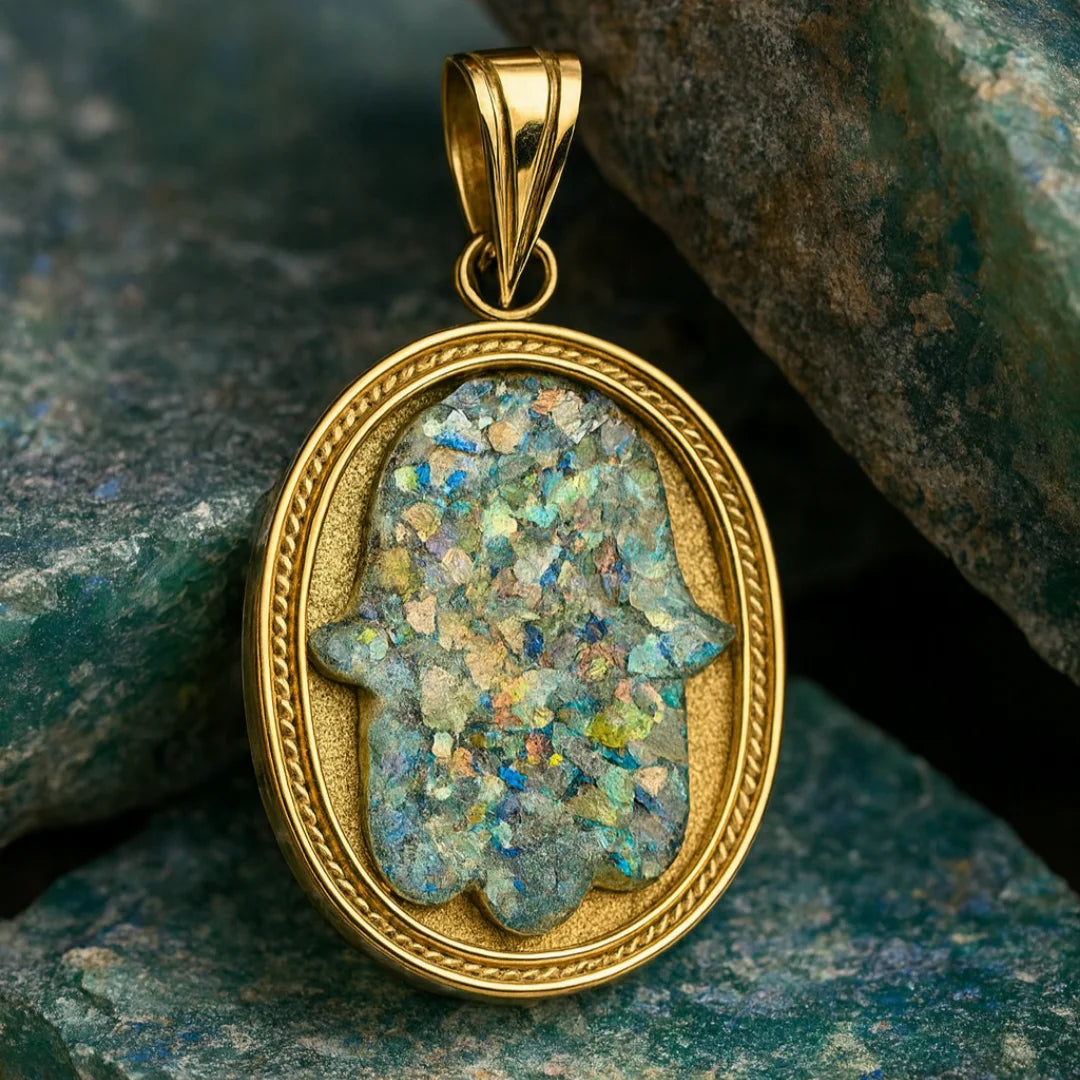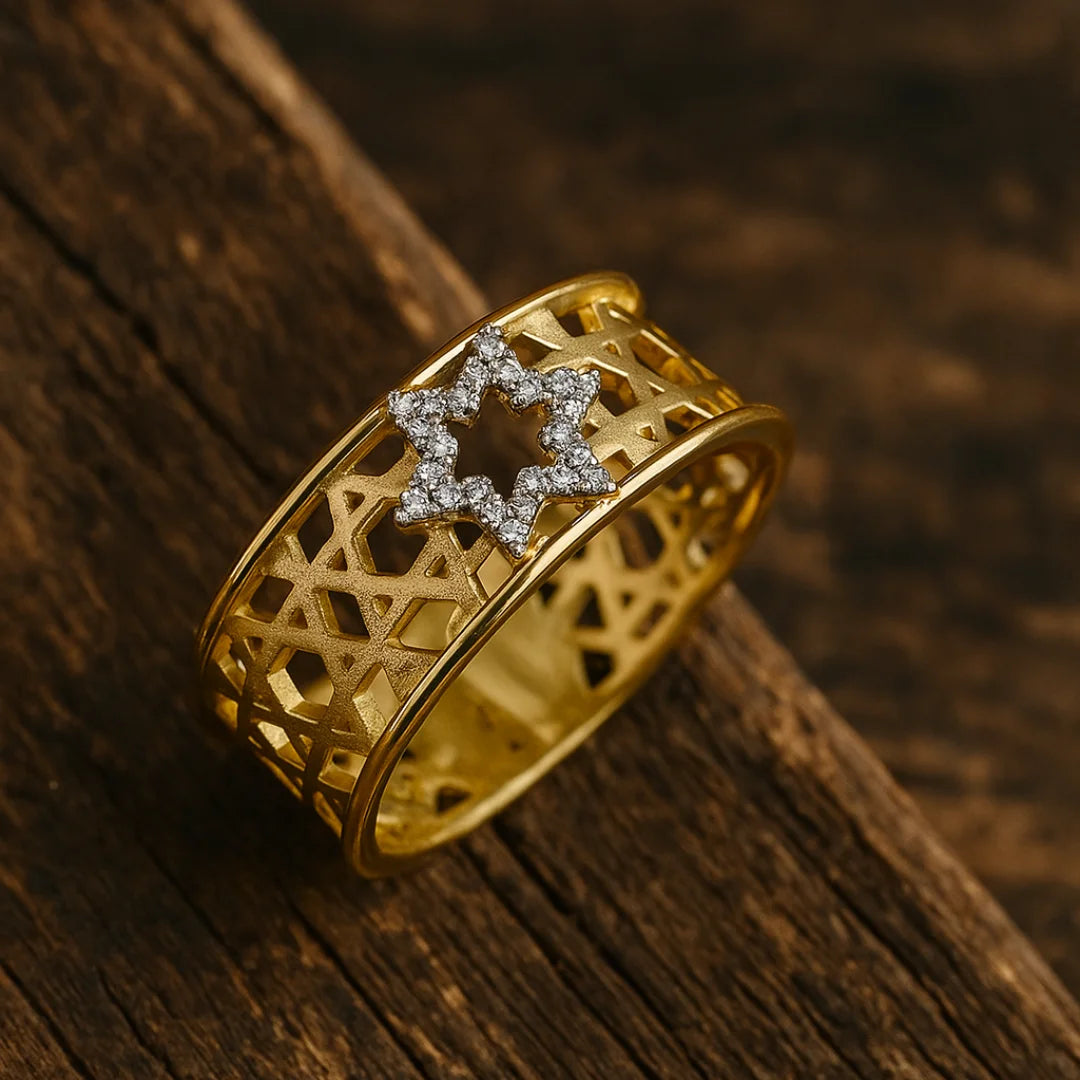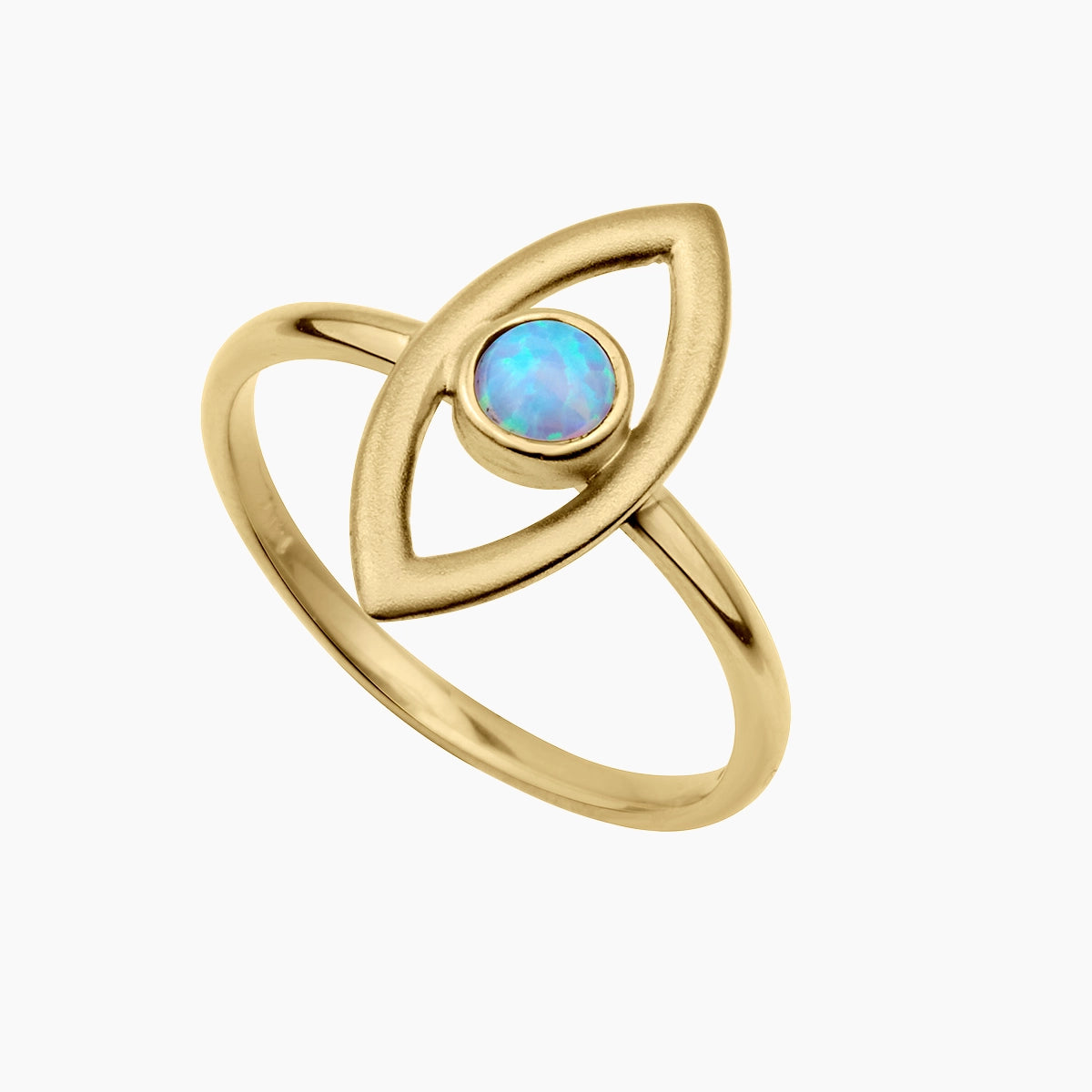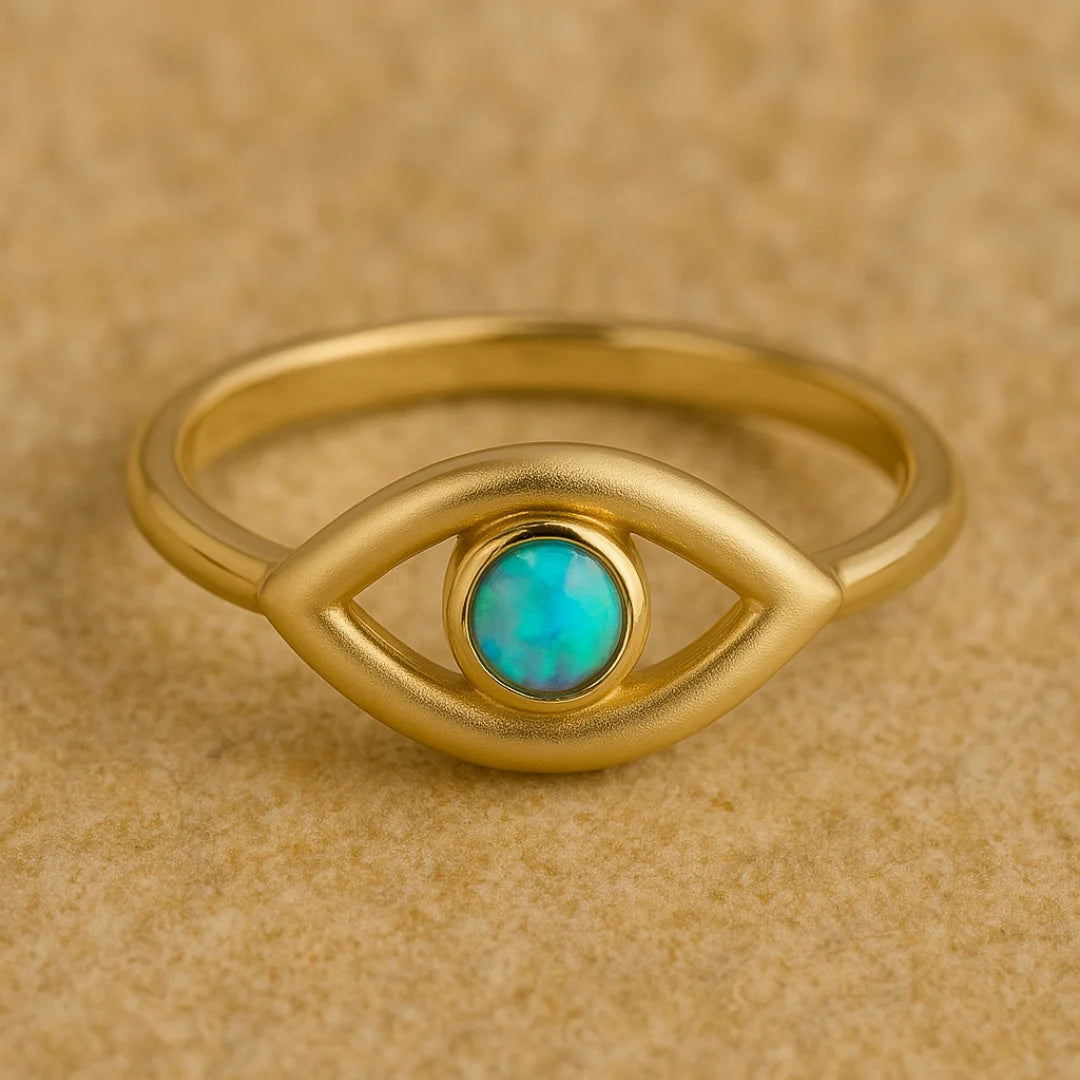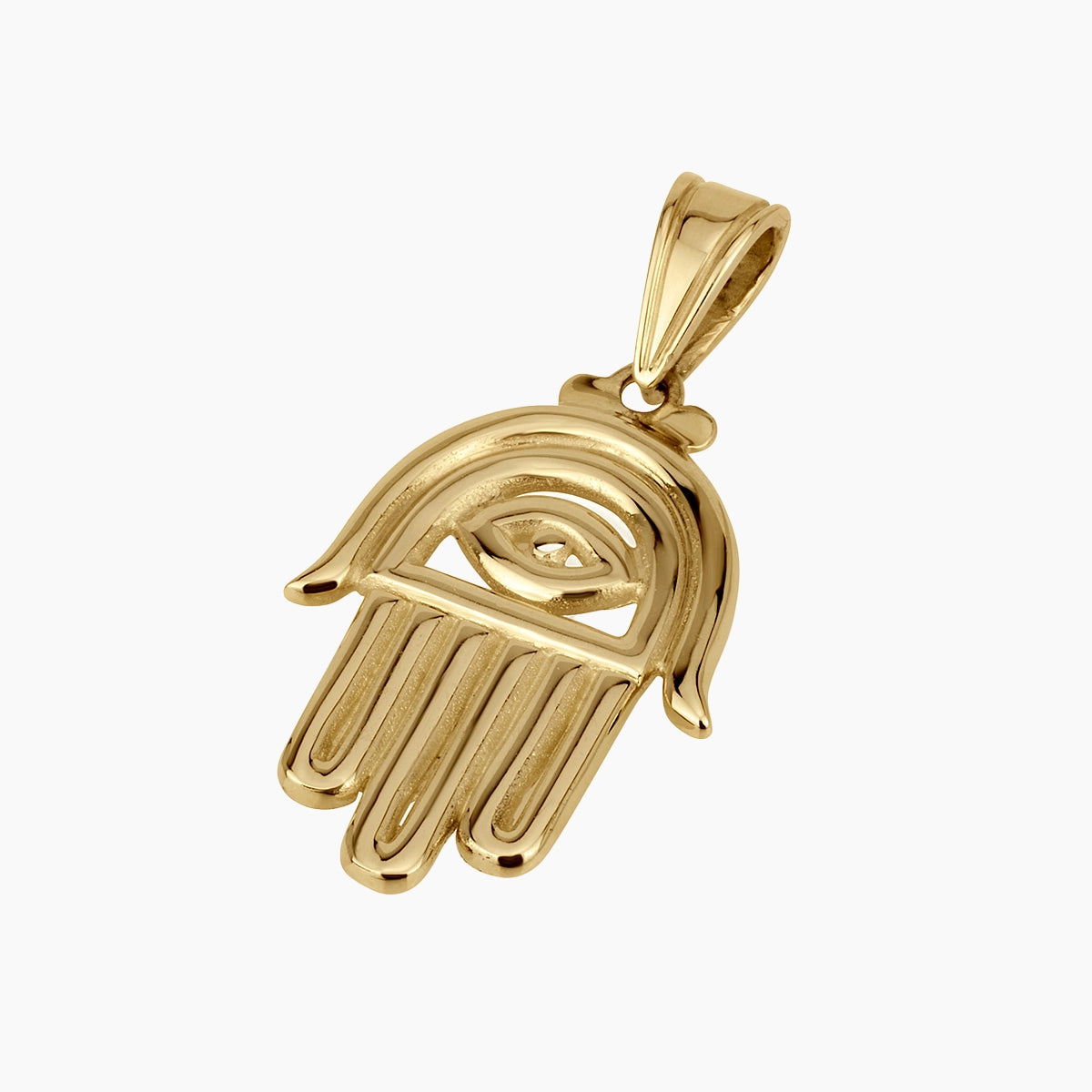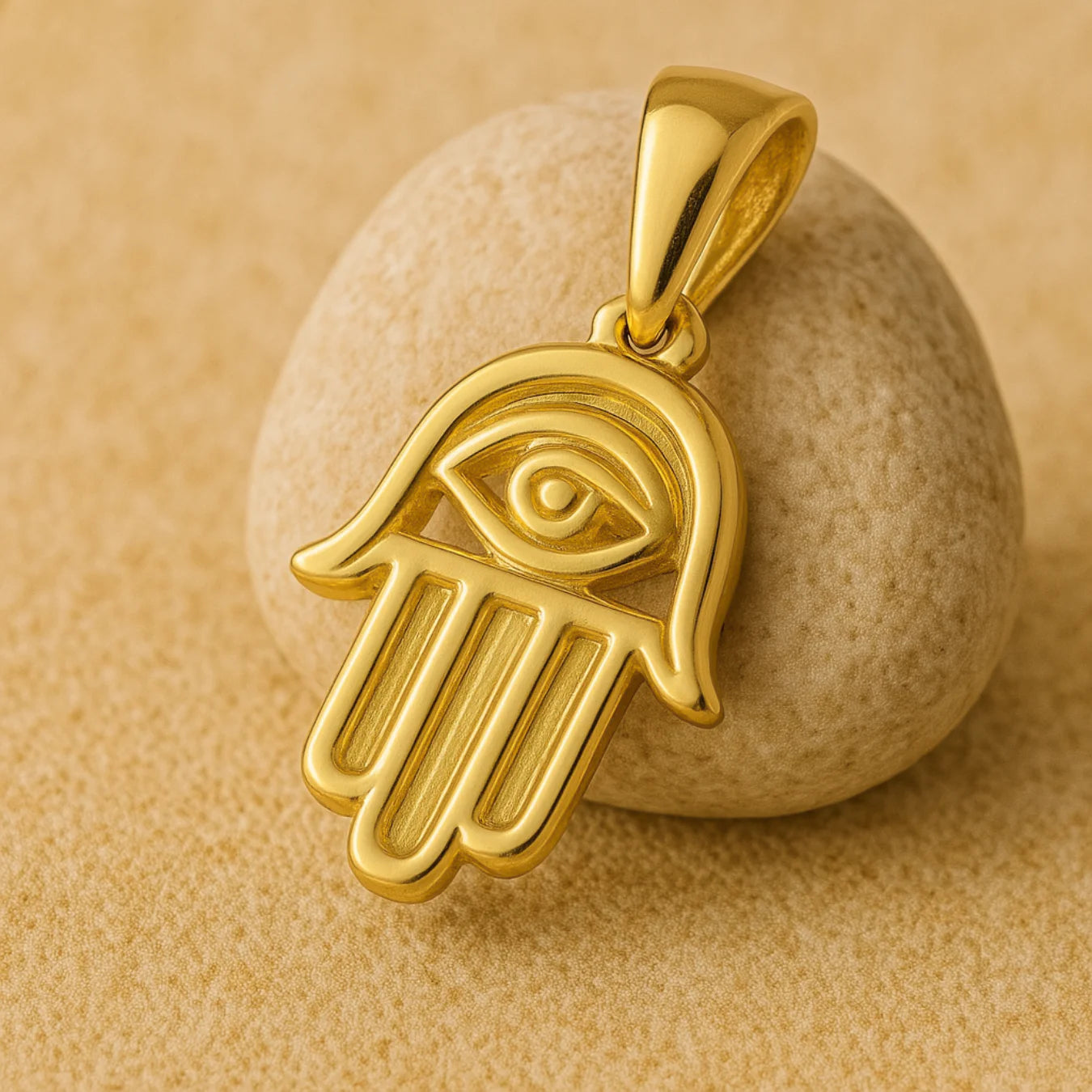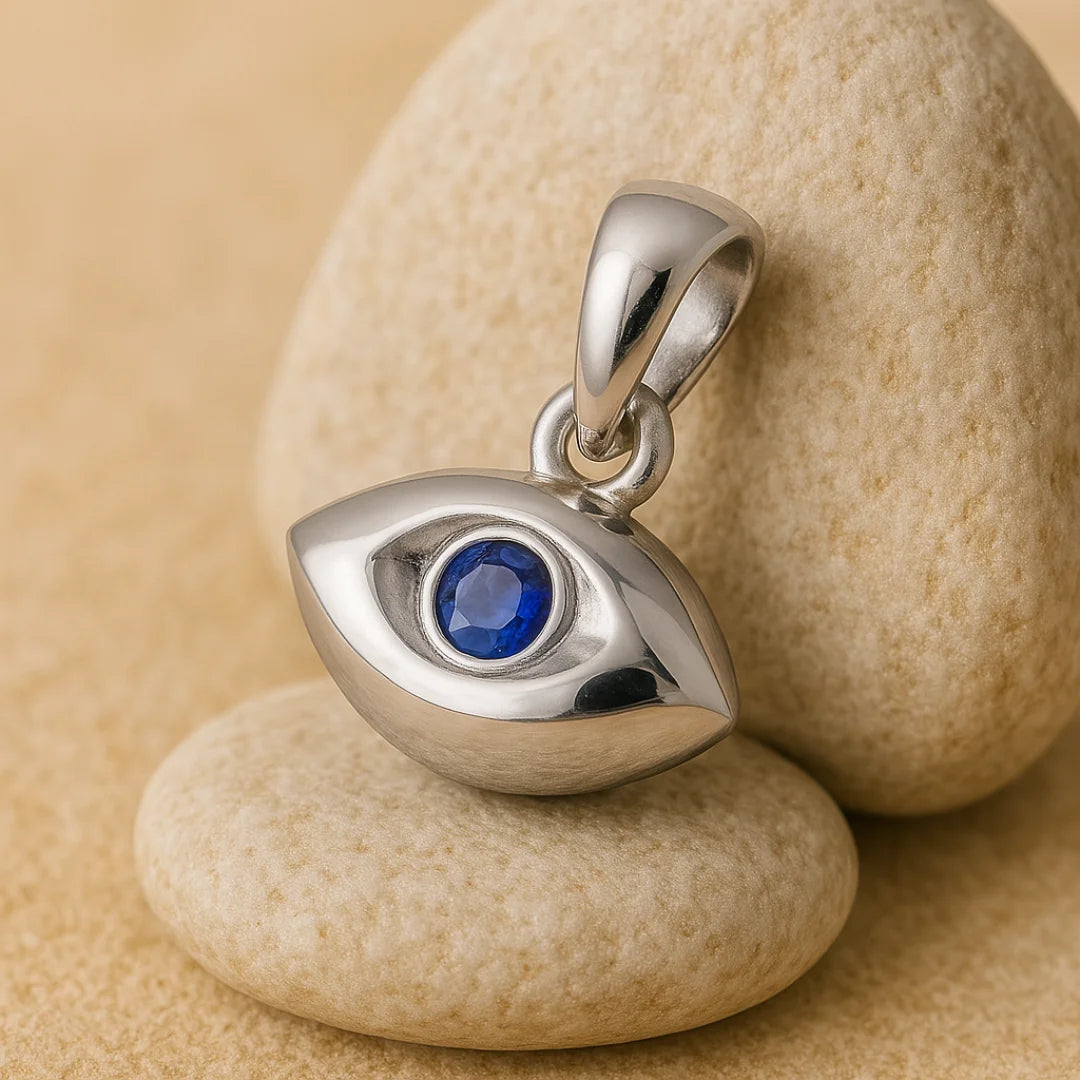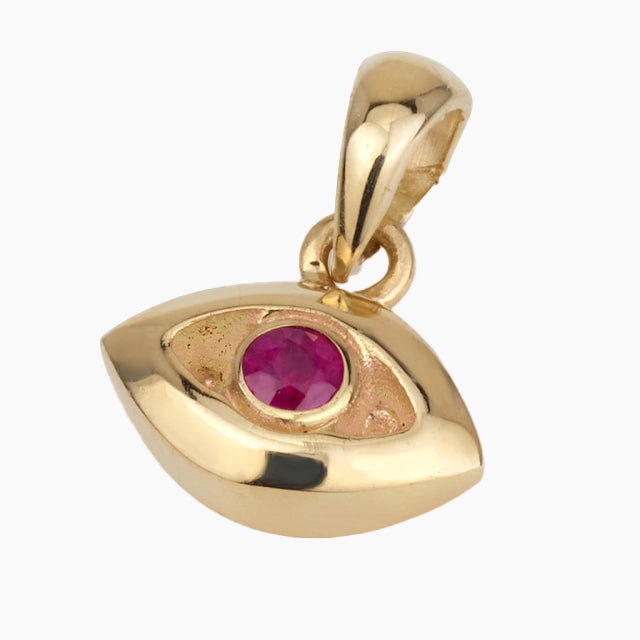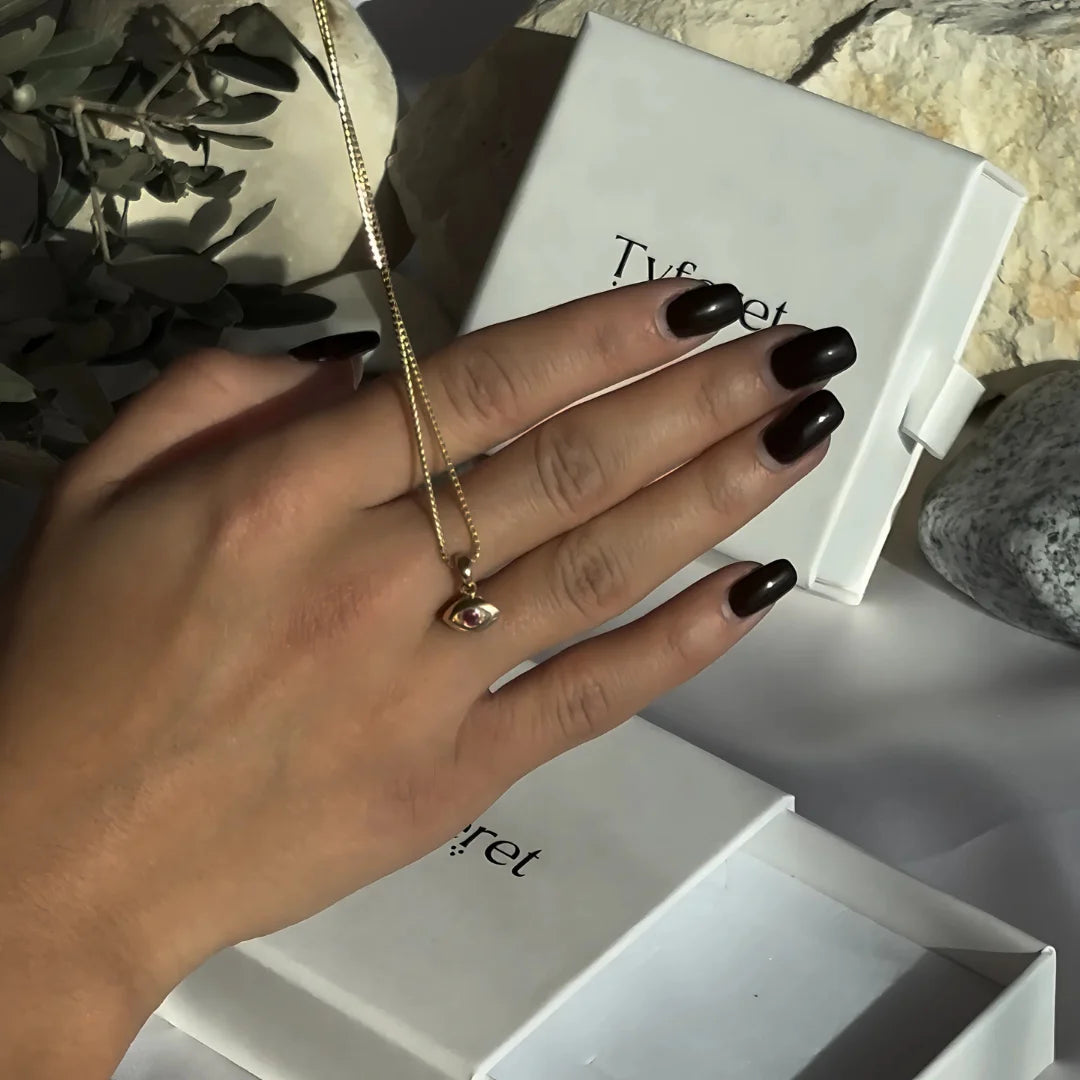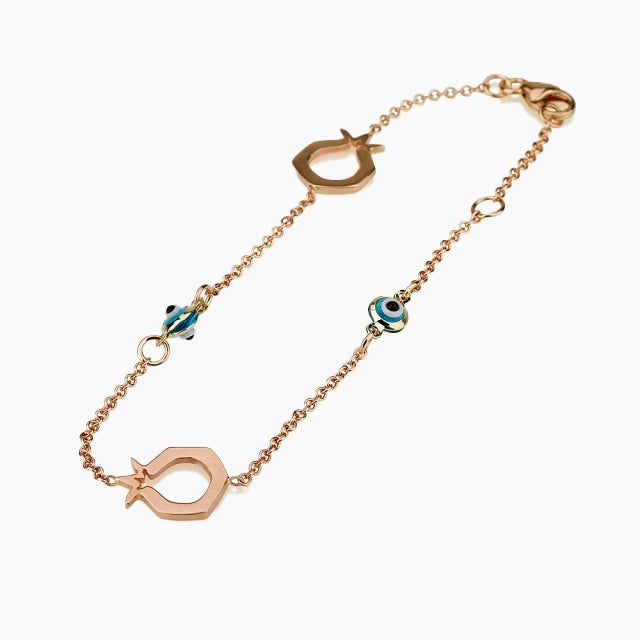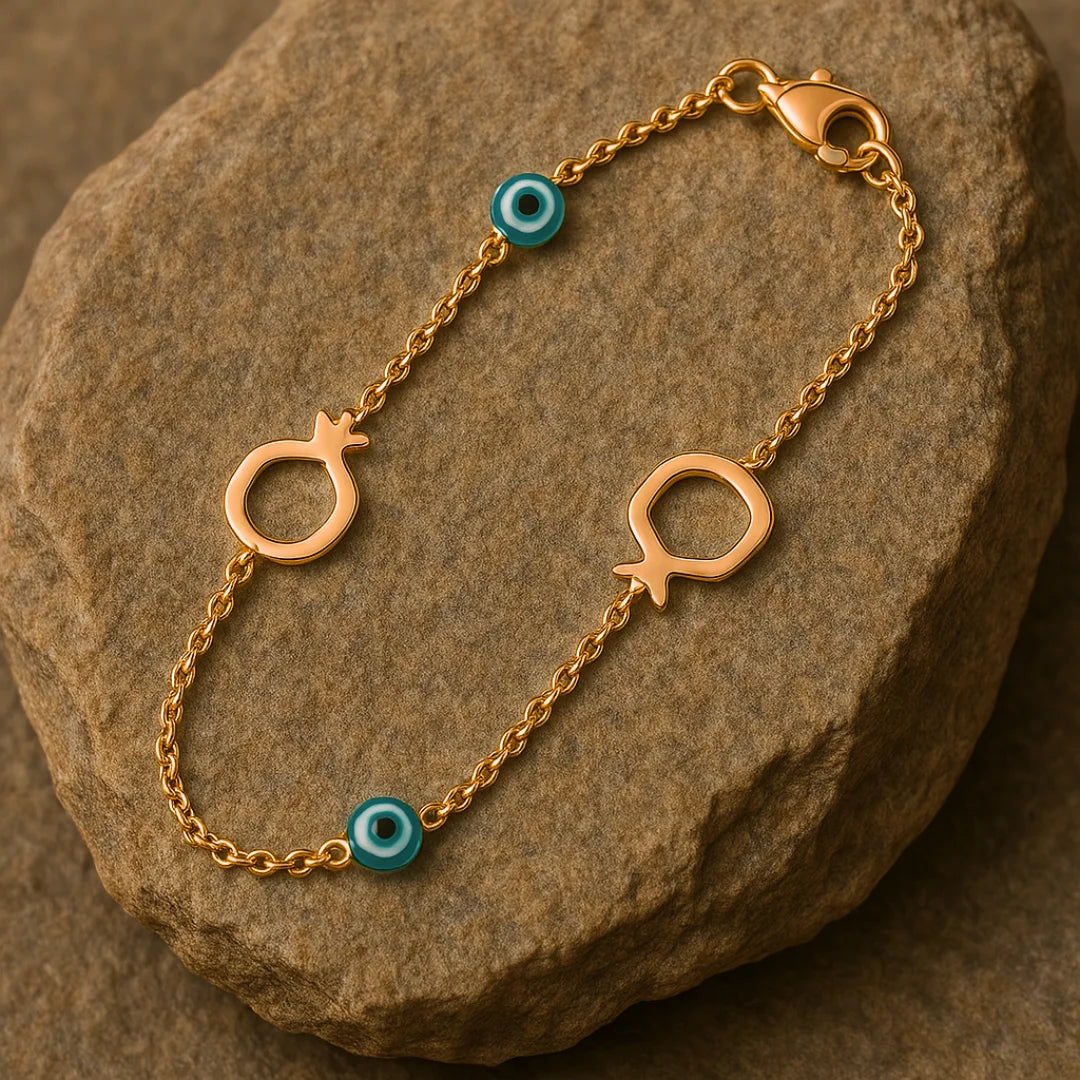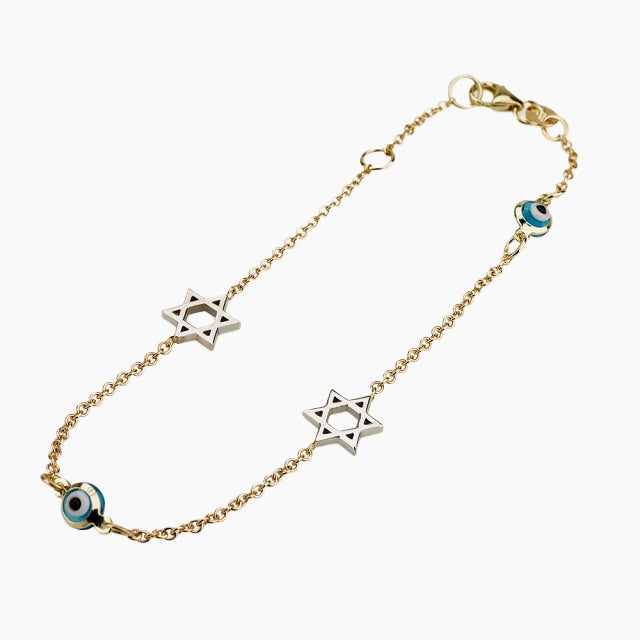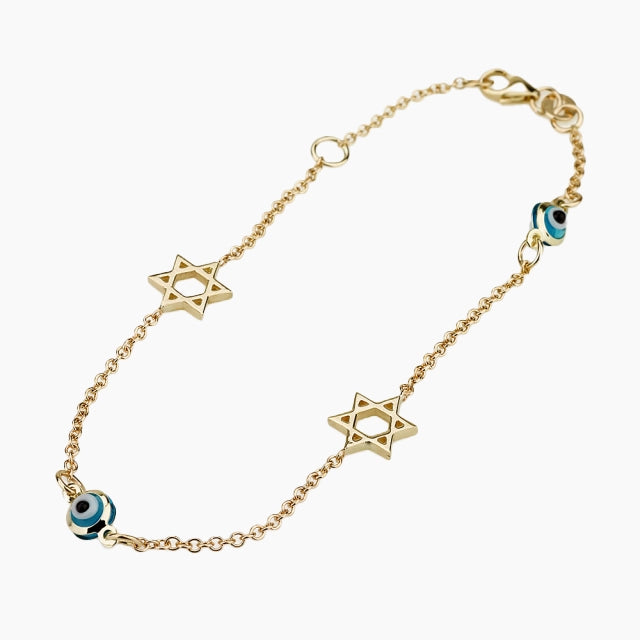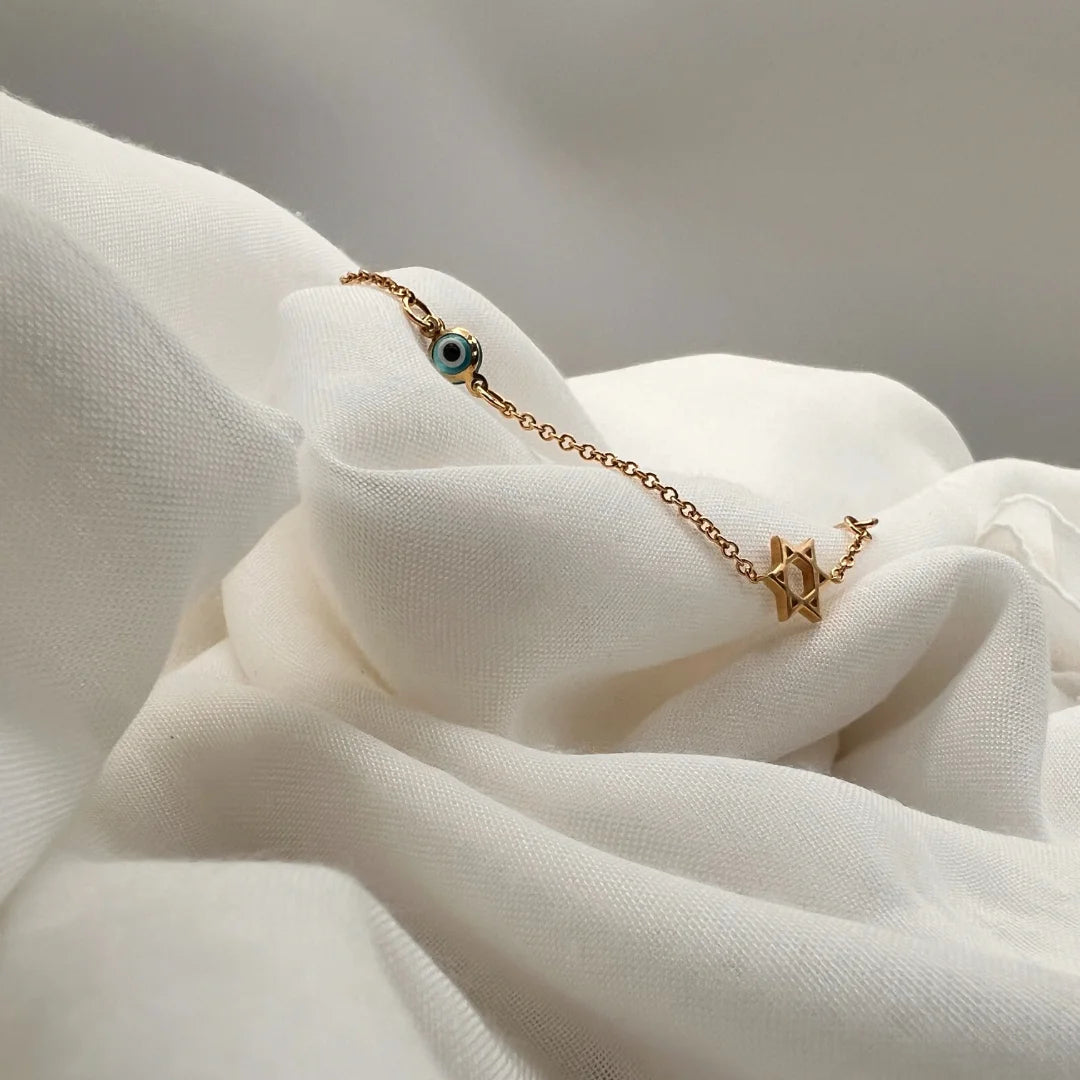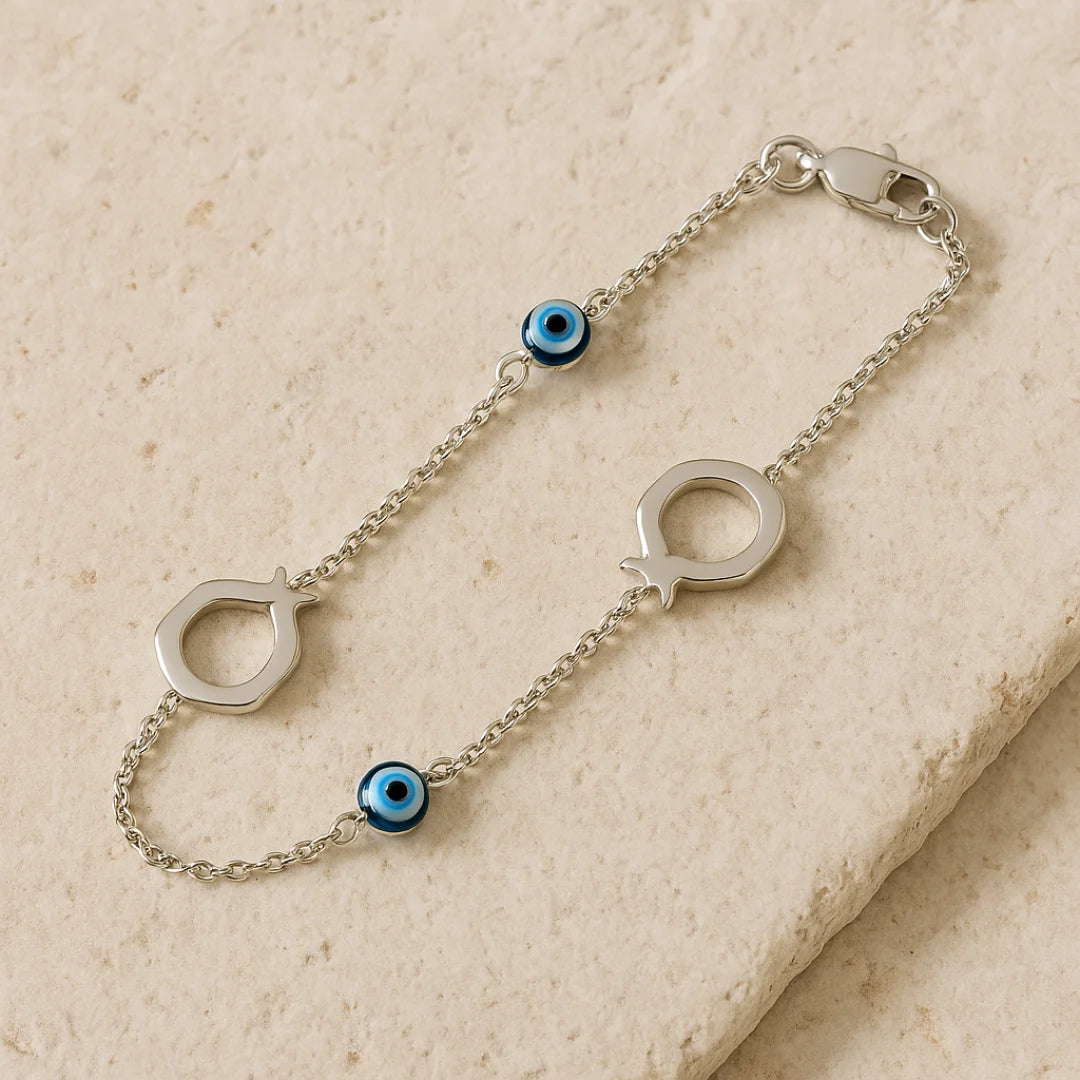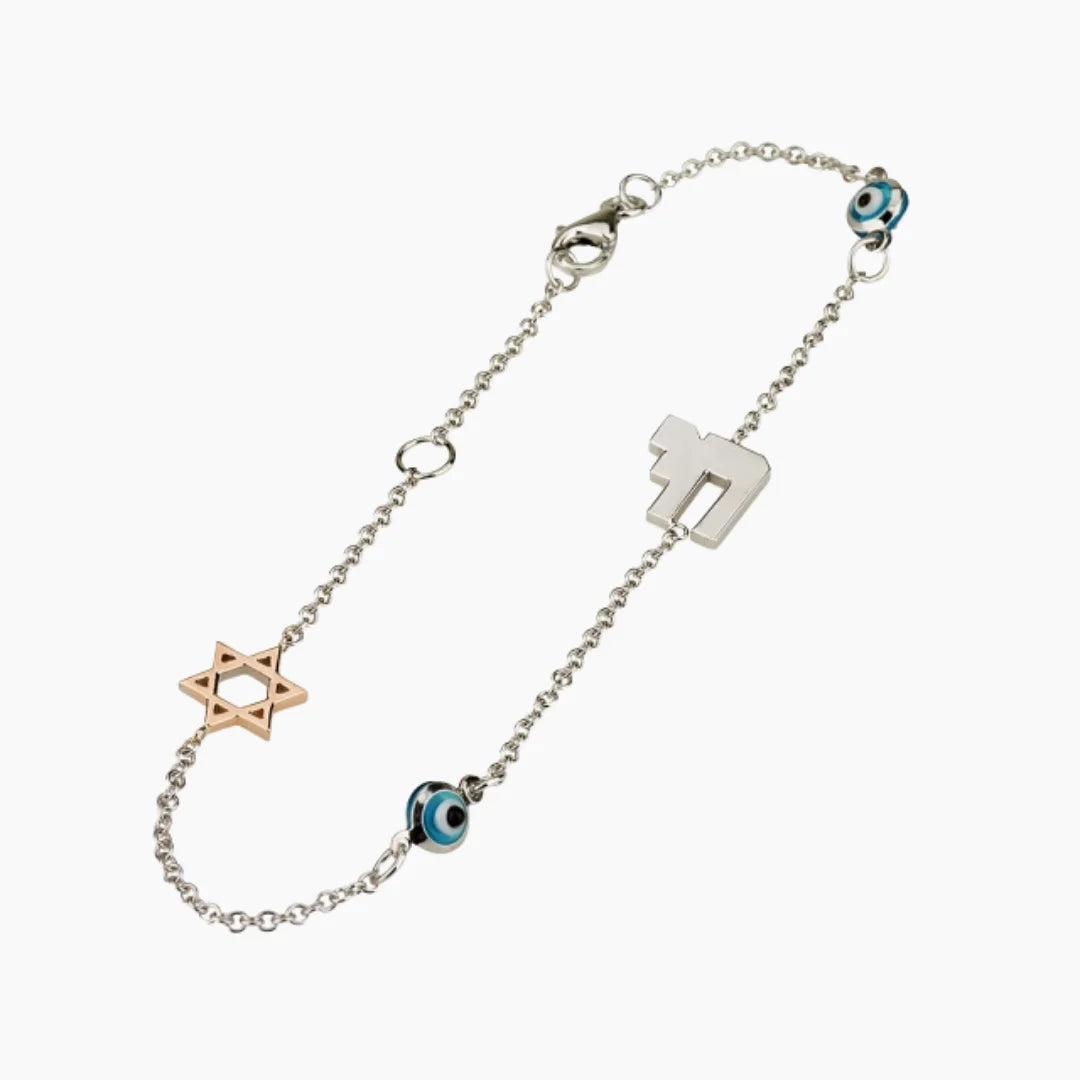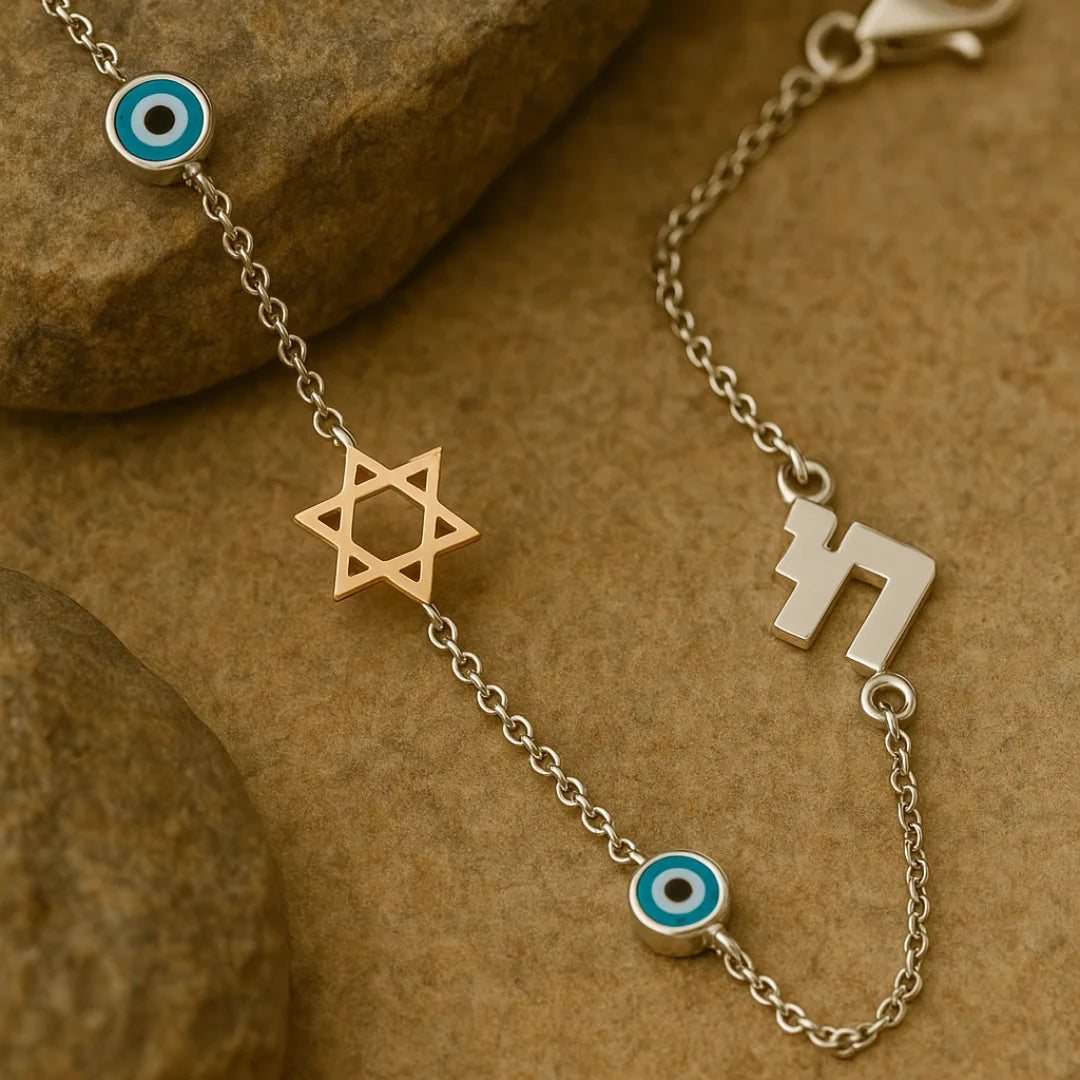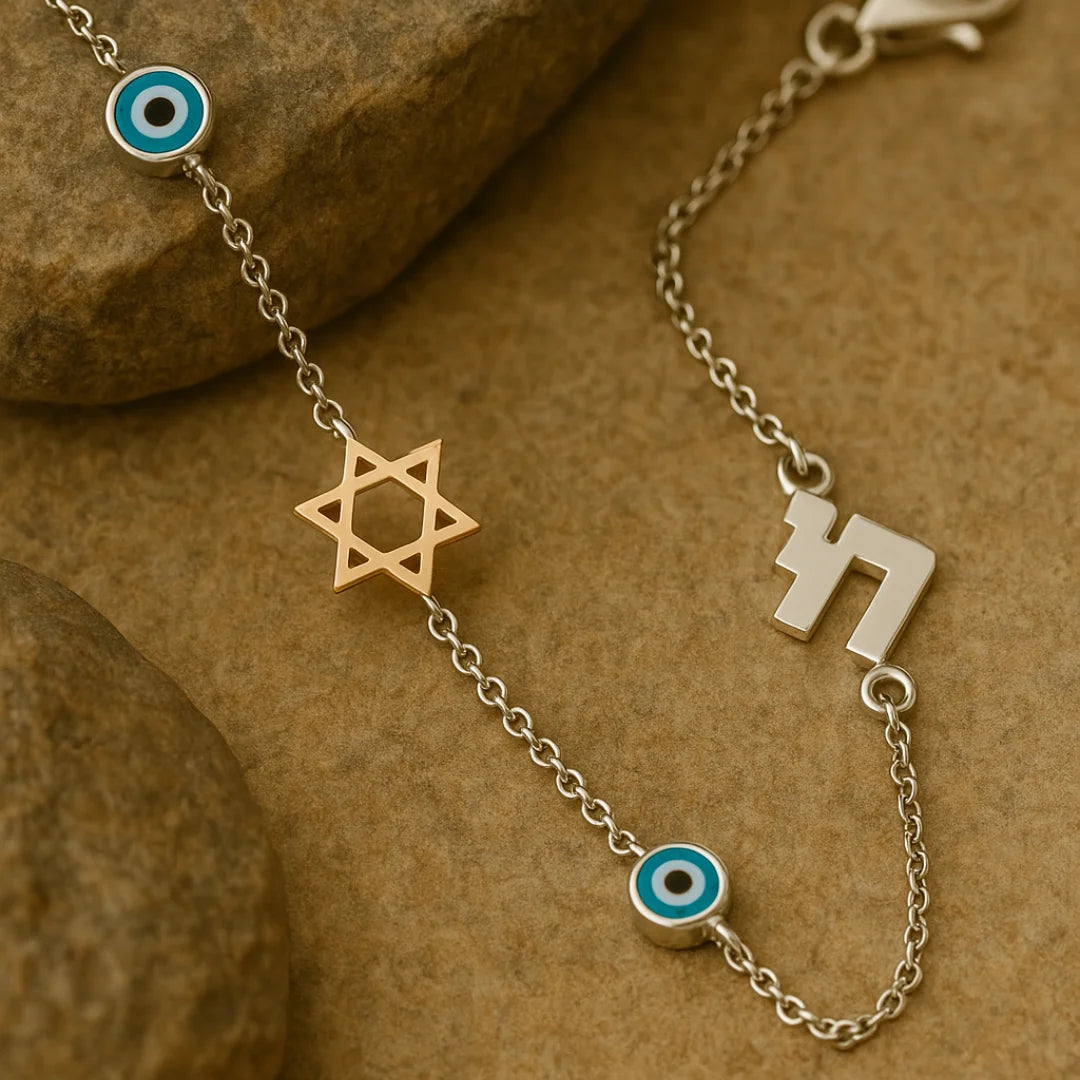
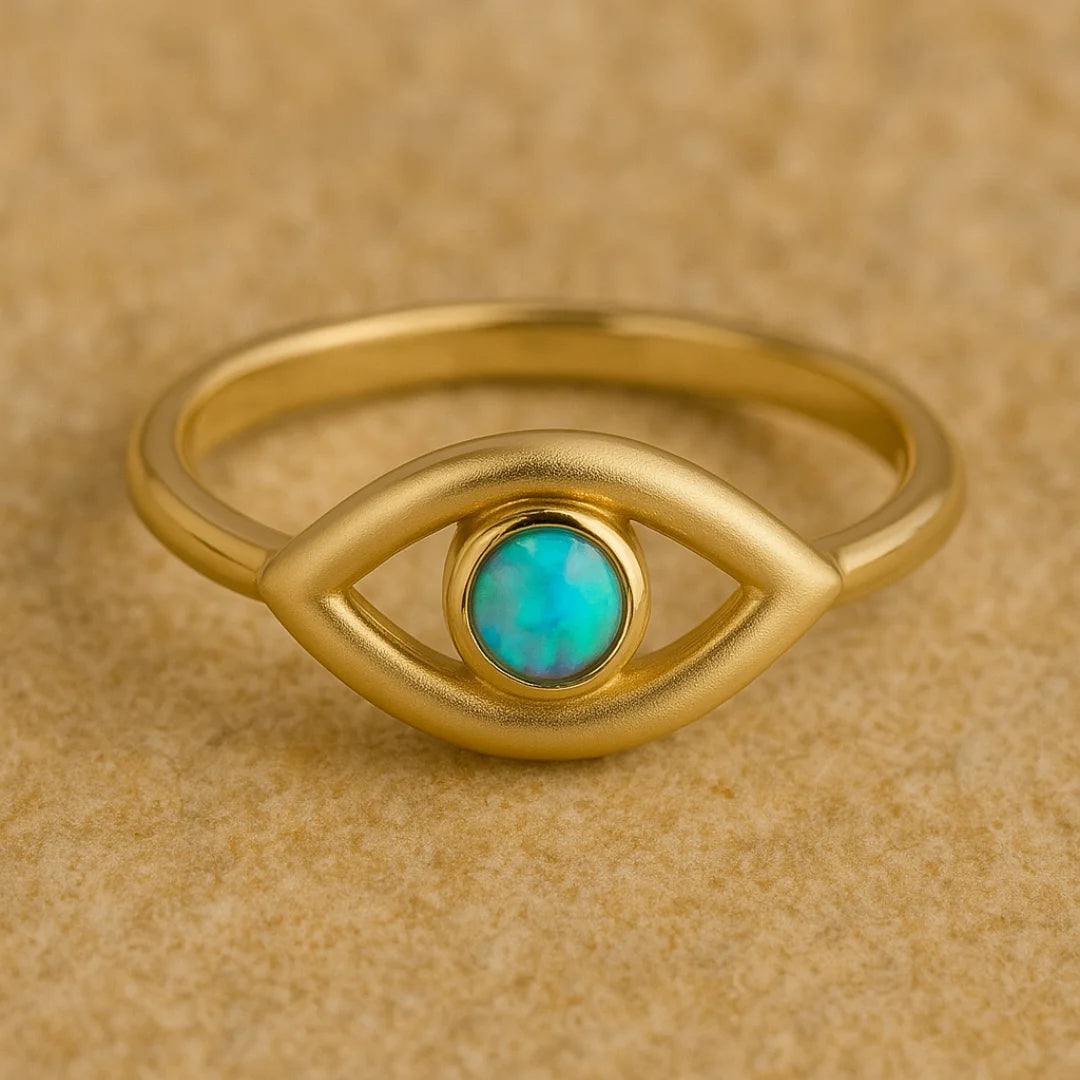
evil eye
What is Evil Eye Jewelry?
For thousands of years, humans have shared the same silent fear: the power of a jealous glance. Cultures called it the "evil eye," and it has given rise to endless stories, rituals and charms to ward off evil. From Mesopotamian clay talismans to Mediterranean glass beads, the evil eye symbol has maintained mystery and significance.
In Judaism, ayin hara - the devastating stare - pervades sacred scripture and worldly ritual, passed along in low-voiced blessing and protection rituals. What were originally simple amulets became valuable pieces of religion and art, which ultimately metamorphosed into jewelry that not only protects but announces heritage and identity.
This piece explores the evil eye's history: how it first came to be, what it was used for within Jewish society, how it evolved into jewelry and what symbolism it holds today.
Ancient Origins of the Evil Eye
The evil eye was said to have originated with ancient cultures who feared harm or malice could be transmitted through the eyes and that such would bring bad luck or disease. To ward off such things, they created protective rituals and symbols - many of which are still in use.
Mesopotamian archaeologists found small stone and clay amulets with inscribed eyes that were thought to keep their wearers safe. Egyptians used the "Eye of Horus" on tombs and jewelry to ward off heavenly evil. Greeks wrote about the danger of a bad-tempered look, while Romans spread the malocchio throughout their empire, leaving mosaics and inscriptions that called down protection.
Evil eye became universal since it was linked to envy. In times of scarcity, jealousy was dangerous. People feared that envy would manifest in the form of harm, so the eye symbol acted as a reflector and reflected back the evil.
Early Amulets and Charms
Evil eye protection amulets were the most sought-after personal objects of the ancient world. Blue and white beads, decorated stone and unadorned pieces of jewelry have been found on grave sites and market stalls from South Asia to the Mediterranean. The colour blue was especially important, symbolizing the heavens and divine protection. These charms were not decorations - they were everyday protection, carried by mothers, farmers and merchants.
The Evil Eye in Jewish Tradition
Ayin hara is not merely a legend among Jews. It can be found in holy scripture, rabbinic law and everyday practice. Jewish tradition often depicts the evil eye as spiritual and moral: hatred and envy have real consequences, not only for the envied but for the envious.
Mentions in Rabbinic Texts
Talmud warns against triggering envy by boasting or show-off. Pirkei Avot (Ethics of the Fathers) lists ayin hara among those traits that distance a person from the world. Rabbis defined the evil eye as spiritual danger and psychological fact - envy can destroy relationships and bring about communal destruction.
The evil eye reminds us of the transience of life and the value of humility. Spiritual leaders explain that boasting about blessings may be resented, but humility brings peace. Psychologically, the concept is the shared fear of being hurt by jealousy, which remains experienced today.
Protection Customs
Jewish communities across centuries developed traditions in order to protect from ayin hara. Sephardic Jews tended to avoid counting babies aloud, whereas Ashkenazi traditions encouraged modesty and humility. Traditional practices included saying "bli ayin hara" ("without the evil eye") after a compliment, banding red strings on the wrist or crib, or spitting thrice in order to drive away symbolically negative energies. Traditions tended to be passed on by mothers, tying protective amulets or blessing mutely. These tiny, private gestures express an abiding belief: love and faith can repel unseen evil.
Evil Eye in The Kabbalah
Kabbalah elaborated on the idea of ayin hara. Mystics clarified that the evil eye was a distortion of balance between spiritual forces, not just human envy. Defense, then, was a matter of restoring balance between power and beauty, judgment and mercy. Painters infused Hebrew letters and sacred names into designs intended to defend the soul.
Evil Eye’s Evolution in Jewish Art & Culture
As Jews became dispersed all over the Middle East, North Africa and Europe, the evil eye began to appear in art, ritual objects and daily life.
Wall hangings with protective prayers, silver amulets with verses and children's apparel with charms all entered Jewish culture. They were both functional symbols of protection and a display of religion.
Sephardic & Ashkenazi The Different Approaches
The Sephardic Jews usually mixed the evil eye with the hamsa hand to create layered amulets that took cues from Jewish and native tradition. The Ashkenazi Jews express the fear in more indirect ways, generally in blessing and prayer, but even there symbols appeared in decorative ketubot (wedding contracts) meant to safeguard couples.
Sephardic & Ashkenazi The Different Approaches
Prophylactic amulets gradually developed into jewelry as time went on. What was first hidden charms eventually became ornaments flaunted. Already by the 6th century BCE, humans used to wear amulets as ornamentation. Jews used to wear pendants with texts or eye-shaped amulets as religious symbols on a daily basis, wearing them with seriousness and honesty.
In the Mediterranean, Greek and Ottoman influence manifested in blue glass beads. Silver amulets with Hebrew letters were preferred by North African Jews. Middle Eastern artisans combined eyes with hamsa in rings and necklaces.
The eye symbol in charms was not only superstition for Jews but humility, trust and divine protection as well. Turning charms into jewelry integrated them into art forms - objects that had heritage and identity close to the individual.
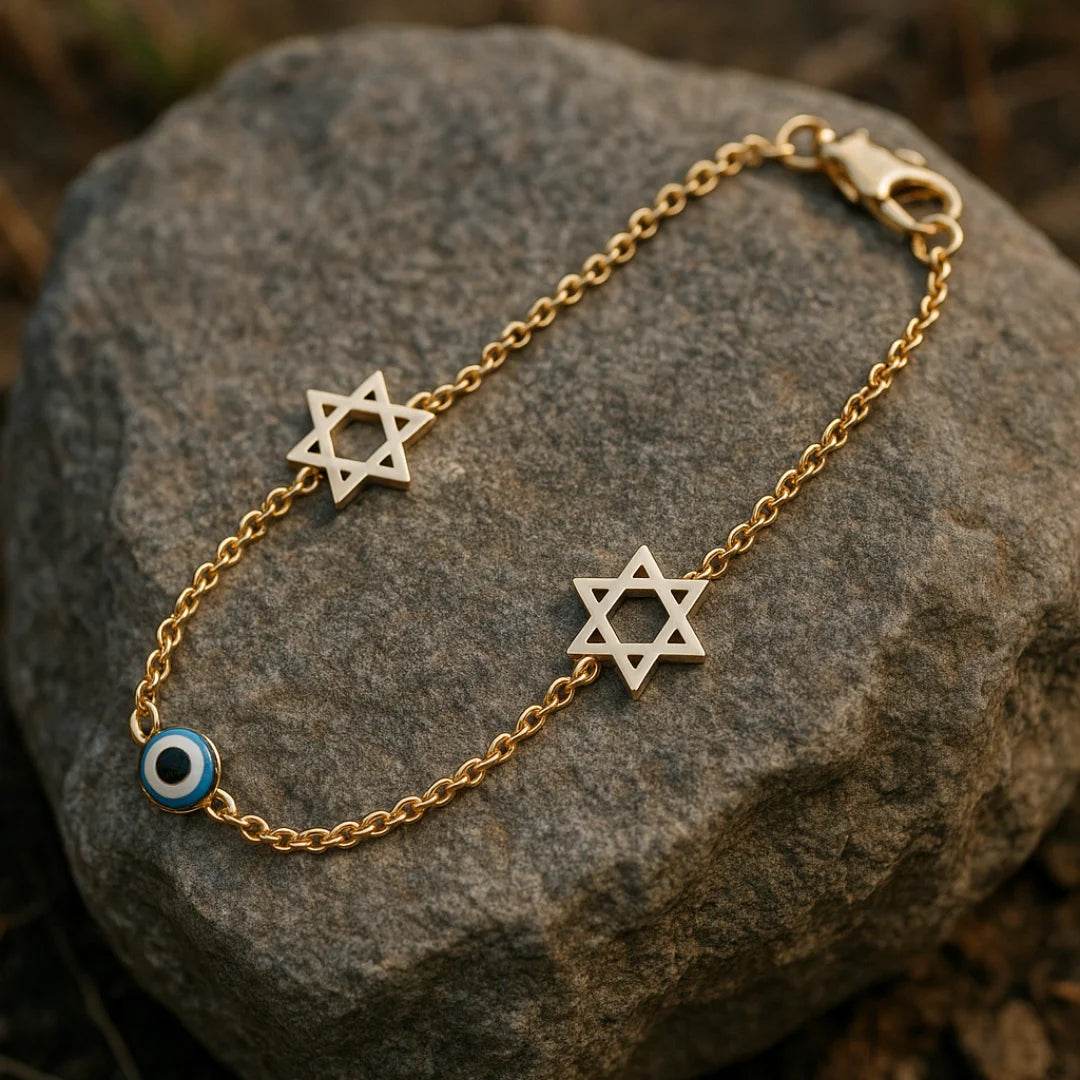

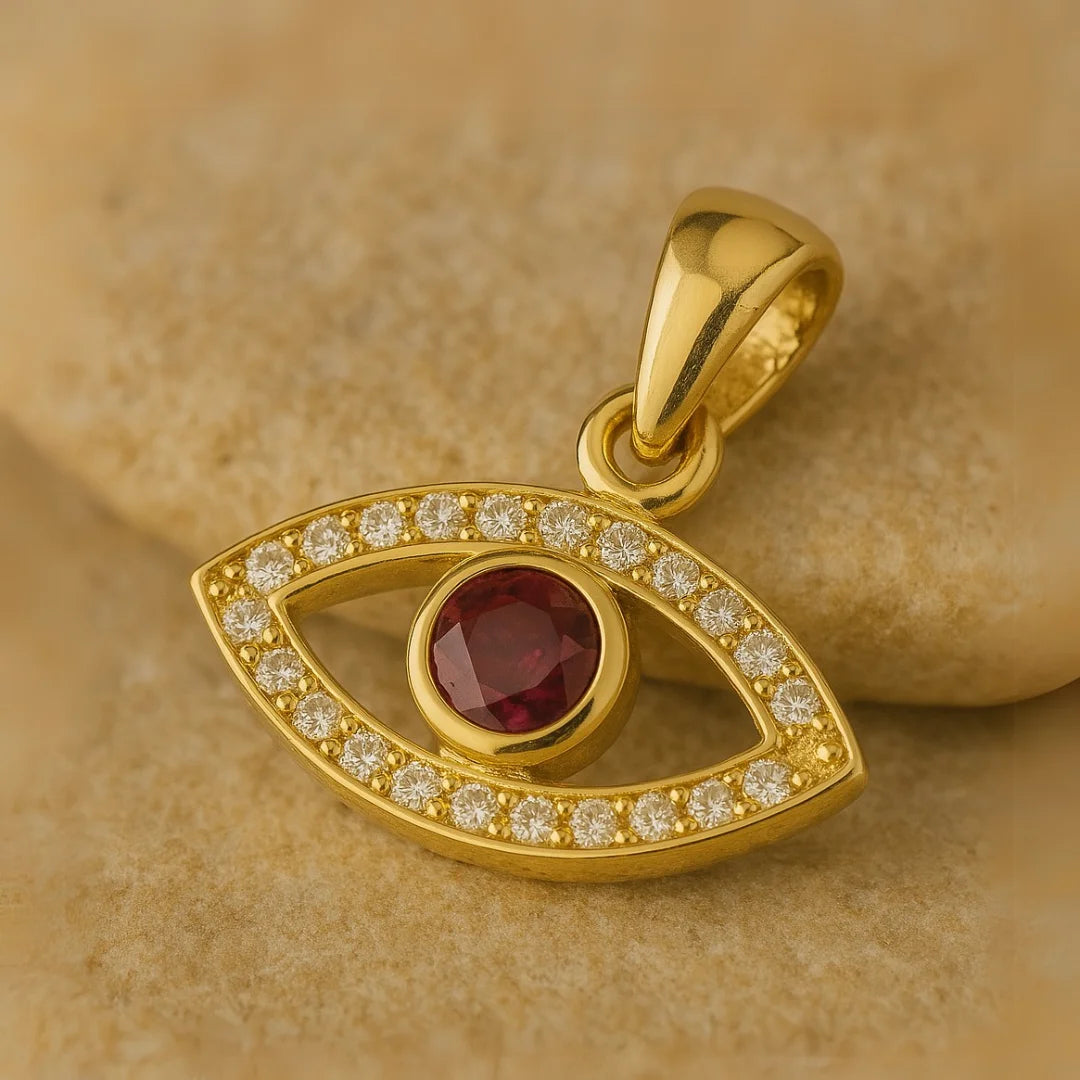
Evil Eye Jewelry in the Modern World
The evil eye has spread across the cultures today and is being worn everywhere. But for the Jews, it remains particularly multi-layered in meaning - religious, cultural and personal. The humble charm of yesteryears now trots down style runways as also in upscale jewelry stores. The designers reinterpret the motif in gold, diamonds and gemstones and confer the icon a new role in modern fashion.
The Emotional Connection
Evil eye jewelry may be more than a simple accessory, it comes with stories and emotions that linger. A necklace can recall the memory of a loving family member who keeps them safe. Such pieces are then silent reminders of love, care and hope, making jewelry personal. For some, wearing an evil eye is also about identity and inner resilience. It can be a way of affirming, "I am safe, I am proud, I am part of it all." When the world appears uncertain, it can be like an armature for the heart, a small and unchanging reservoir of strength and comfort that says everything without speaking.
Today, evil eye jewelry is not only protection, but also a show of Jewish identity. Wearing one can be an affirmation of faith, stubbornness and pride. During times when Jewish visibility is on the verge of becoming problematic, a gold pendant or gemstone-encrusted ring is a discreet sign of resilience.
What is an Evil Eye Bracelet?
Of all evil eye jewelry forms, bracelets are today among the most symbolic and popular. In contrast to a pendant resting close to the heart, a bracelet is always visible on the wrist, believed to absorb negative energy before it reaches the wearer. It is therefore an everyday practical as well as symbolic method of gaining protection.
Historically, evil eye symbol bracelets were presented to children, brides and grooms and travelers alike as a way of surrounding them with blessings and protection. The ring shape of the bracelet itself, going all the way around the entire wrist, came to represent continuity, an unbroken circle of faith and strength.
Now, evil eye bracelets range from simple blue-and-white beads to beautifully crafted gold pieces adorned with diamonds, sapphires, or rubies. Both children and adults wear them, at times stacked on top of other meaningful charms like the Hamsa or Star of David. Aside from beauty, bracelets are also passed down as family heirlooms, both carrying the significance of protection and the memory of the donor who loved them.
For some, setting the evil eye bracelet on a worthy basis each day is routine rather than ritual, a worthy reminder that they are safe, overseen and part of a heritage.
Today, evil eye jewelry is not only protection, but also a show of Jewish identity. Wearing one can be an affirmation of faith, stubbornness and pride. During times when Jewish visibility is on the verge of becoming problematic, a gold pendant or gemstone-encrusted ring is a discreet sign of resilience.
Designs, Materials & Meanings
From yesterday's primitive beads to elegant gold trinkets of today. Every choice, form, color, or material, is eloquent speaking volumes telling a story of tradition and personal taste.
The blue-and-white circle is the most classic evil eye of them all. This design was meant to "reflect" malevolent gazes back away from the wearer. Blue has, historically, been the protective color in Jewish and Mediterranean cultures, synonymous with the sky, water and divine presence. The circle itself symbolizes wholeness and continuation, reminding us that life goes in circles and we are constantly being watched over.
Gold, Diamonds & Precious Stones
Evil eye jewelry has come a long way today. Instead of glass beads, pendants, rings and bracelets are fashioned out of gold today by artisans. They are often studded with diamonds, sapphires, or rubies. These are converting an age-old protective emblem into magnificent jewelry which also carries a spiritual quality about it and refinement. To others, a gold evil eye may be a protection; to others, it's also a fashion statement.
Ancient Talismans VS Contemporary Jewelry
Ancient amulets were not very decorative and were hidden under clothing, employed only for protection. Nowadays, the art is more imaginative and displayed openly. People will layer it with other meaningful symbols like the Star of David or the Hamsa. What originally concerned covering up fear is now about proclaiming identity, strength and pride. Evil eye jewelry also tells of endurance in trying times, trust in protection from something greater than us and communion with our forebears. It's a way of passing along stories and beliefs that span millennia.
Protection Heirlooms
Beyond form and symbolism, evil eye jewelry is efficacious because of the stories passed down regarding it. There are many who receive evil eye jewelry as an heirloom. A mother can give a wedding-day necklace to her daughter. A grandmother can pass down a bracelet she has been wearing for years to her descendants. These pieces contain blessings, love and memories, which make them treasures that protect and connect across generations. To pass on evil eye jewelry is traditional because of the protective power. We believe that donating such an item continues the protection it initially afforded to protect the next generation. Doing so makes the jewelry larger, it is a blessing passed down, a love protection meant to defend the wearer.
Faith, Fear & Comfort
Jewish communities across the globe have turned to evil eye jewelry during times of insecurity. A tiny pendant to be carried away on a long arduous journey, a pretty charm placed beside one in the anxious hours before childbirth, or a bangle held close to face a life-altering decision. In all such cases, the jewelry does more than provide cosmetic beauty, it is an unspoken friend, a companion who provides strength when speech or comfort is hard to find. These are the instances that illustrate just how intimate the attachment to such jewelry can be. To the wearer, it is a reminder of faith in something beyond, safeguarding against the unknown. In times when life feels vulnerable, the evil eye comes not as jewelry but as an inner source of strength close to heart.
The Future of Evil Eye Jewelry
Evil eye is not just an ancient symbol, it is also transformative and impacting today. In a global world where trends are so quick to be disseminated on the web, there is a demand to make sure that the original sign is sustained. For Jewish fashion designers and wearers, it's important that the evil eye as a symbol remains blessing, humility and protection even if it has become more popular in mainstream fashion. That is why patterns like Roman glass and Eilat stone are becoming popular in evil eye jewelry. They do not only add beauty, they add history, tracing every piece back to heritage and retaining its meaning.
Spirituality with Modern Aesthetics
Designers are creating new styles of wearing the evil eye: plain pendants, bold rainbow-colored rings and layered bracelets that combine the eye with other symbols. The new designs render the jewelry modern, allowing the wearer to manifest their spirituality in a style that is both timeless and new.
For future generations, the evil eye will be more than a mere accessory. It will continue to be a symbol of protection and pride. As a family heirloom or a newly acquired item, it will tell stories of strength, beauty and belongingness. In this regard, the evil eye will never be an accessory, but a guardian and chronicler for future decades.
More Than Ornament, A Living Legacy
The evil eye jewelry has existed for thousands of years and still exists today. From pendants made of gold to amulets made of clay, its form has changed but the need has remained constant: the wish to possess something sacred, the potential for blessings and the hope of protection.
In times of turmoil, the evil eye remains permanent. Gold and gem, beauty and strength and belief are merged as it has been passed down for generations. Wearing it now, we carry history and faith and the hope that light will always overcome malice.
Featured collection
Evil Eye Jewelry
Handmade 14k Solid Gold & Opal Evil Eye Ring
14K Gold Hamsa Pendant With Evil Eye
14K Gold Eye pendant with Sapphire
14K Gold Eye Pendant With Ruby
14k gold Jewish Bracelet
Eternal 14K Rose Gold Bracelet with Eye and Pomegranate Charms
14K Yellow & White Gold Bracelet with Star of David & Evil Eye Charms
14k Gold Jewish Bracelet with Star of David & Evil Eye Charms
Heritage 14K White Gold Bracelet with Eye and Pomegranate Charms
Heritage 14K White Gold Bracelet with Jewish Charms
Frequently Asked Questions
Yes, the evil eye can be worn by anyone. Although the belief took root in ancient societies and is deeply ingrained in Judaism, Islam, Christianity, Hinduism, and Mediterranean societies, the symbol has been embraced worldwide. For some, it is religious; for others, cultural, symbolic, or simply decorative. One does not need to be of a specific religion to wear the evil eye, it is largely accepted as a universal symbol for protection against envy and negative energies.
Blue has also been associated with protection and divinity for thousands of years. Blue is the color of the sky and water in Mediterranean and Jewish tradition, symbols of infinity, purity, and God's protection. Blue eyes were also once unusual and therefore potent, feared and respected. The blue-and-white concentric circle ultimately became the most common design for the evil eye, which is believed to reflect negative energy back to its source.
Many people believe that if an evil eye bracelet, pendant, or charm breaks, it has fulfilled its purpose. The idea is that the jewelry absorbed or deflected the negative energy meant for you, and in doing so, it cracked or broke. Instead of being seen as bad luck, it’s often viewed as proof that the charm worked. Traditionally, a broken evil eye piece is replaced with a new one to continue the protection.
Evil eye jewelry is any type, bracelet, necklace, ring, or earring, that contains the symbol of the eye, classically blue and white, but now also in gold, diamonds, and other precious gems. The jewelry serves to avert ayin hara (the evil eye), the superstition that jealousy or envy will cause injury. These protective amulets became over time not just spiritual helpers but also items of art, blending heritage and fashion. Evil eye jewelry is for many not just protection but also a personal identity, memory, and pride statement.
Evil eye jewelry is popular today for two reasons: meaning and fashion. Spiritually, people still look for means to protect against negativity and to wear a symbol of blessing and strength. Emotionally, the pieces also remind wearers of family tradition, prayer, or heritage. Designers, meanwhile, have reworked the symbol in fine gold, diamonds, and modern styles, and it is now fashionable on the catwalk and in everyday fashion. This combination of deep tradition and contemporary styling has turned evil eye bracelets and necklaces into timeless accessories that transcend ages.

